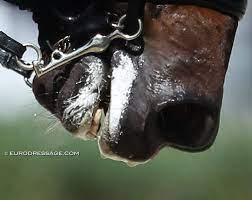Pretty sure the horse that’s running backwards when being taught to wear a bridle is not ready for showing and hopefully won’t need candy to get a bit in its mouth by that point.
oh do I ever WISH that was an issue here. Way underweight and rough coats…no necks…its awful.
What shows are you seeing that at? Just curious because I think we’re in the same general area.
There are very pathetic barns sadly.
I think you’re GTA?
Yes, but closer to Hamilton than Toronto
Yeah I’m about 2 hrs east of Toronto… not a lot happening here haha
Gotcha, I thought you were on this side of the GTA for some reason.
I don’t get it. Copious amounts of foam and drool are not actually desirable–it often means the horse can’t swallow (typically because overbent or not let out enough from the poll so that the actual throat space is open and not smashed up.
I don’t get it. Copious amounts of foam and drool are not actually desirable–it often means the horse can’t swallow (typically because overbent or not let out enough from the poll so that the actual throat space is open and not smashed up.
I did a google image search and the pictures don’t show copious amounts, just what looks like a moderate schmear.
Here’s an image from eurodressage.com:

I have never understood the appeal of foam at all. To me it is a sign the horse’s mouth is moving too much, or too much tension.
Then again, I stopped being a dressage purist years ago. Certain – many – parts of the sport leave me cold.
The sport turns me off, but the discipline itself is thrilling.
I just hang out there for shows a lot of the time hahah
I have never understood the appeal of foam at all. To me it is a sign the horse’s mouth is moving too much, or too much tension.
Then again, I stopped being a dressage purist years ago. Certain – many – parts of the sport leave me cold.
I’m going to butcher the explanation of why I was taught foam is good, but I’ll try. When the core muscles are engaged, the lower neck muscles (can’t remember the name off the top of my head) have more space to relax. When those muscles relax, the hyoid also relaxes and allows the drool/foam to flow freely. As with everything else, people took it to the extreme and decided that more foam = more relaxation.
But I’m far from a dressage expert so someone correct me if I’m wrong!
Why not just put a little honey on the bit, as was advised in the old days?
As with everything else, people took it to the extreme and decided that more foam = more relaxation.
Too much/too thick foam usually means tension, though. The stuff that looks like meringue (or marshmallow fluff…), thick and dripping all over = tension. The natural foam is created by the mouth softly working the bit, and should be just a slight lip gloss of light foam, like steamed milk. I have no idea why you’d want to falsify a tense mouth using fluff!
I can not be the only one that thinks fluff should not be wasted in this way, can I? I mean… really… Fluff is wonderful stuff with many glorious uses, none of which involve my horse.
I think it’s two different worlds. I took my pony out to a tiny local show for miles and I saw same as you…I think it’s primarily the old rickety schoolies who are painfully willing their old bones around courses with kids bouncing on them. And some did look really underfed, although if I had to guess they were probably fed “enough” by the charts, just worked too hard in too much pain.
And on the flip side, I DO think the rated hunters look pretty round and soft, at least to those of us in eventing and/or fox hunting land where the horses get a lot more cardio. I think it’s the bias towards warmbloods, they are easier keepers in general vs TBs, tend to have a naturally rounder frame. And they are so BIG these days that it doesn’t take much effort to step over a 2’6” course in a laid back manner.
That’s what we were always taught, a little lipstick. I think the gobs of foam on a tense horse looks like a sloop cresting a dirty roiled sea. Growing up on the sea, we knew a lot of foam meant something big and stinky died, like a whale or an algal bloom. Smelled as you would expect.
I knew a woman who has Saddlebreds and she used a sugary syrup on the bit to teach the babies to take the bit. She continued to use it with her adult horses, at least at home. Not sure if she used it at shows. But boy, I have never seen horses that literally reach and open their mouths for the bit like those guys did. I certainly see the value in using it as a teaching tool, especially for that woman who was petite and whose horses were tall and upright.
My current horse was, when I first bought her, reluctant to take the bit. I just dipped it into molasses and suddenly it was a taste treat! I only did that for a couple of weeks, and she’s been completely happy to take the bit since then.
The molasses had no noticeable impact on the creation of foam.
After some of the comments above about “good” foam looking like steamed milk, I was thinking that people should really be serving their horses a nice cafe latte prior to the test (decaf of course!)
